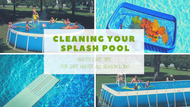
It only takes a few minutes a week to keep your pool water sparkling clean and healthy. Here are a few tips:
Keep the water circulating! The center of the circulation system is the pump. It moves the water from your pool and sends it to the filter for removal of any dust, dirt, and debris before sending it back to the pool. If your pump is not running, the water from your pool is not being properly circulated or filtered. A good rule of thumb is to run your pump about 1 hour for every 10 degrees of temperature.
Maintain the filtration system. Always consult your owner’s manual for specifics related to the type of filter you have and to understand the role that the skimmer and pump basket play in keeping your pool clean. Understanding how each part works will aid in maintaining it so that it can remove any undissolved dirt and debris from the pool water.
Test your pool water. You should test your pool’s water 2-3 times per week during the summer and once a week during the winter. This is important for maintaining adequate water balance and sanitizer levels to insure swimmer comfort. Proper testing also ensures that calcium levels are maintained, and that there are no metals present in the pool water. To prevent scaling or corrosive action, your pool’s water should be balanced to the following levels:
- pH – pH should be tested and adjusted, if necessary, on a weekly basis. Keeping the pH in check will allow you to use the full potential of the chlorine already in the pool. If you maintain a pH of around 7.5, the chlorine will be about 50-60% active.
- Calcium hardness – Low calcium hardness levels can shorten the life of vinyl liners. High calcium levels can result in calcium deposits on pool surfaces and equipment. The proper range for calcium hardness in all Splash pools is 175-225ppm.
- Total alkalinity – The proper amount of acid buffers, total alkalinity. must be maintained to prevent the pH from fluctuating. Test weekly to ensure that total alkalinity stays in the 120-150 ppm range.
- Metals – There should be NO metals found in your pool’s water. If metals are present, a stain and scale remover should be used on a regular basis to prevent staining. Determine the source of the metals and remove it, if possible.
- Chlorine – Stabilized chlorine products sanitize your pool water and kill bacteria; they are protected from sunlight degradation and are an ideal means to keep your pool water clean and clear. A free chlorine level of 1-3 ppm should always be maintained.
- Shock – Shocking the pool on a regular basis is important in eliminating waste that can create problems such as algae and cloudy water.
- Algaecide – Algaecides act as a backup sanitization program and prevent algae from starting to grow. This should be added after every shock treatment.
View our selection of Splash Pool Parts here: http://bit.ly/2LMF9jf

